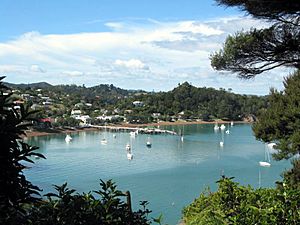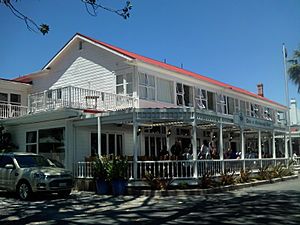Russell, New Zealand facts for kids
Quick facts for kids
Russell
Kororāreka
|
|
|---|---|
|
Town
|
|

Russell
|
|
| Country | New Zealand |
| Region | Northland Region |
| District | Far North District |
| Ward | Bay of Islands-Whangaroa |
| Community | Bay of Islands-Whangaroa |
| Subdivision | Russell-Ōpua |
| Settled | Early 19th century |
| Named for | John Russell, Secretary of State for the Colonies |
| Electorates |
|
| Area | |
| • Total | 3.28 km2 (1.27 sq mi) |
| Population
(June 2023)
|
|
| • Total | 790 |
| • Density | 240.9/km2 (624/sq mi) |
| Postcode |
0202
|
Russell, also known by the Māori name Kororāreka, is a town in the Bay of Islands, in New Zealand's far north. It was the first permanent European settlement and seaport in New Zealand.
History
When European and American ships began visiting New Zealand in the early 1800s, the indigenous Māori quickly recognised there were great advantages in trading with these strangers, whom they called tauiwi. The Bay of Islands offered a safe anchorage and had a high Māori population. To attract ships, Māori began to supply food and timber. What Māori wanted was respect, plus firearms, alcohol, and other goods of European manufacture.
Kororāreka developed as a result of this trade but soon earned a very bad reputation, a community without laws and became known as the "Hell Hole of the Pacific", despite the translation of its name being "How sweet is the penguin", (korora meaning blue penguin and reka meaning sweet). European law had no influence and Māori law was seldom enforced within the town's area. Fighting on the beach at Kororāreka in March 1830, between northern and southern hapū within the Ngāpuhi iwi, became known as the Girls’ War.
On 30 January 1840 at the Christ Church, Governor Hobson read his Proclamations (which were the beginnings of the Treaty of Waitangi) in the presence of a number of settlers and the Maori chief, Moka Te Kainga-mataa. A document confirming what had happened was signed at this time by around forty witnesses; including Moka, the only Maori signatory. The following week, the Treaty proceedings would then move across to the Western side of the bay to Waitangi.
By this time, Kororāreka was an important mercantile centre and served as a vital resupply port for whaling and sealing operations. When the Colony of New Zealand was founded in that year, Hobson was reluctant to choose Kororāreka as his capital, due to its bad reputation. Instead he purchased land at Okiato, situated five kilometres to the south, and renamed it Russell in honour of the Secretary of State for the Colonies, Lord John Russell. Captain Hobson soon decided that the move to the Okiato site was a mistake, and Auckland was selected as the new capital not long after.
Kororāreka was part of the Port of Russell and after Russell (Okiato) became virtually deserted, Kororāreka gradually became known as Russell also. In January 1844, Governor Robert FitzRoy officially designated Kororāreka as part of the township of Russell. Today the name Russell applies only to Kororāreka while the former capital is known either by its original name of Okiato or as Old Russell.
At the beginning of the Flagstaff War in 1845 (touched off by the repeated felling and re-erection of the symbol of British Sovereignty on Flagstaff Hill above the town), the town of Kororāreka/Russell was sacked by Hōne Heke, after diversionary raids drew away the British defenders. The flagstaff was felled for the fourth time at the commencement of the Battle of Kororāreka, and the inhabitants fled aboard British ships, which then shelled and destroyed most of the houses. Hōne Heke directed his warriors not to interfere with Christ Church and the Pompallier Mission.
In 1841–42, Jean Baptiste Pompallier established a Roman Catholic mission in Russell, which contained a printing press for the production of Māori-language religious texts. His building, known as Pompallier Mission, remains in the care of Heritage New Zealand.
Demographics
Russell covers 3.28 km2 (1.27 sq mi) and had an estimated population of 790 as of June 2023, with a population density of 241 people per km2.
| Historical population | ||
|---|---|---|
| Year | Pop. | ±% p.a. |
| 2006 | 786 | — |
| 2013 | 702 | −1.60% |
| 2018 | 762 | +1.65% |
| 2023 | 798 | +0.93% |
Russell had a population of 798 in the 2023 New Zealand census, an increase of 36 people (4.7%) since the 2018 census, and an increase of 96 people (13.7%) since the 2013 census. There were 384 males, 408 females and 3 people of other genders in 408 dwellings. 3.0% of people identified as LGBTIQ+. The median age was 61.0 years (compared with 38.1 years nationally). There were 57 people (7.1%) aged under 15 years, 66 (8.3%) aged 15 to 29, 342 (42.9%) aged 30 to 64, and 330 (41.4%) aged 65 or older.
People could identify as more than one ethnicity. The results were 84.6% European (Pākehā); 21.8% Māori; 1.5% Pasifika; 1.9% Asian; 1.1% Middle Eastern, Latin American and African New Zealanders (MELAA); and 2.3% other, which includes people giving their ethnicity as "New Zealander". English was spoken by 98.5%, Māori language by 4.9%, and other languages by 12.8%. No language could be spoken by 0.8% (e.g. too young to talk). The percentage of people born overseas was 33.1, compared with 28.8% nationally.
Religious affiliations were 24.4% Christian, 0.4% Hindu, 1.5% Māori religious beliefs, 1.1% Buddhist, 0.8% New Age, 0.4% Jewish, and 0.8% other religions. People who answered that they had no religion were 62.4%, and 8.6% of people did not answer the census question.
Of those at least 15 years old, 150 (20.2%) people had a bachelor's or higher degree, 366 (49.4%) had a post-high school certificate or diploma, and 177 (23.9%) people exclusively held high school qualifications. The median income was $32,500, compared with $41,500 nationally. 63 people (8.5%) earned over $100,000 compared to 12.1% nationally. The employment status of those at least 15 was that 258 (34.8%) people were employed full-time, 123 (16.6%) were part-time, and 15 (2.0%) were unemployed.
Much of the accommodation in the area consists of holiday homes or tourist accommodation.
Marae
The local Kororāreka Marae is a traditional meeting ground of Te Kapotai, a hapū of Ngāpuhi.
Climate
Russell experiences a mild subtropical climate.
| Climate data for Russell (15m, temperature + sunshine data 1991-2020, rainfall data 1981-2010) | |||||||||||||
|---|---|---|---|---|---|---|---|---|---|---|---|---|---|
| Month | Jan | Feb | Mar | Apr | May | Jun | Jul | Aug | Sep | Oct | Nov | Dec | Year |
| Mean daily maximum °C (°F) | 25.0 (77.0) |
25.2 (77.4) |
23.6 (74.5) |
21.3 (70.3) |
18.9 (66.0) |
16.6 (61.9) |
16.0 (60.8) |
16.4 (61.5) |
17.7 (63.9) |
19.3 (66.7) |
21.1 (70.0) |
23.3 (73.9) |
20.4 (68.7) |
| Daily mean °C (°F) | 19.6 (67.3) |
19.9 (67.8) |
18.4 (65.1) |
16.2 (61.2) |
14.2 (57.6) |
12.1 (53.8) |
11.3 (52.3) |
11.7 (53.1) |
12.9 (55.2) |
14.3 (57.7) |
16.0 (60.8) |
18.0 (64.4) |
15.4 (59.7) |
| Mean daily minimum °C (°F) | 14.2 (57.6) |
14.6 (58.3) |
13.2 (55.8) |
11.1 (52.0) |
9.5 (49.1) |
7.6 (45.7) |
6.6 (43.9) |
7.0 (44.6) |
8.1 (46.6) |
9.3 (48.7) |
10.9 (51.6) |
12.7 (54.9) |
10.4 (50.7) |
| Average rainfall mm (inches) | 91.4 (3.60) |
86.7 (3.41) |
115.7 (4.56) |
117.3 (4.62) |
130.1 (5.12) |
144.1 (5.67) |
172.0 (6.77) |
146.1 (5.75) |
120.9 (4.76) |
96.5 (3.80) |
88.8 (3.50) |
90.4 (3.56) |
1,400 (55.12) |
| Mean monthly sunshine hours | 235.0 | 201.7 | 168.2 | 164.3 | 153.2 | 131.8 | 141.2 | 152.3 | 170.4 | 197.7 | 206.3 | 264.8 | 2,186.9 |
Economy
Russell is now mostly a "bastion of cafés, gift shops and B&Bs".
Pompallier Mission, the historic printery/tannery/storehouse of the early Roman Catholic missionaries, is the oldest surviving industrial building in New Zealand, while the town's Christ Church is the country's oldest surviving Anglican church. The surrounding area also contains many expensive holiday homes, as well as New Zealand's most expensive rental accommodation, the Eagles Nest. The photographer Laurence Aberhart lives here.
A car ferry across the Bay of Islands runs between Okiato and Opua, and is the main tourist access to Russell. There is a land connection, but this requires a substantial detour (the ferry route is only 2.3 kilometres, while the land route is 43.5 km).
Education
Russell School is a coeducational full primary (years 1–8) school with a roll of 69 as of February 2024. The school opened in 1892.
Notable people
- Lucy Takiora Lord (1842–1893), guide and interpreter


